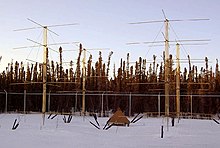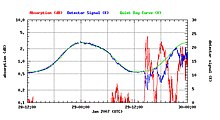Riometer
A Relative Ionospheric Opacity Meter or riometer for short is a device for passive observation of the ionospheric absorption capacity in the frequency range of radio waves .
Working principle
A riometer measures the reception strength of the cosmic background radiation in the area of the radio waves, which are continuously emitted by stars or galaxies and which reach the earth after crossing the ionosphere ( radio window ). Although the strength varies with the rotation of the earth, it is nevertheless sufficiently constant and thus predictable for earthly scales, depending on the region of the sky. In particular, the absorption is measured at heights of up to 110 km, as the majority of the absorption takes place in the lower layers of the ionosphere located there, such as the so-called D-layer .
Depending on the degree of ionization , the size of the absorption in the ionosphere varies. In the event of a malfunction z. B. by a solar radiation burst , the ionization in the lower ionosphere and thus the attenuation of the radio waves increases. If the ionosphere is calm, however, the radio waves pass through it without being attenuated in addition to the expected level. This results in a normal course of the received field strength over time. The normal, time-of-day-dependent attenuation of the D-layer is already included in this.
The example opposite shows such a reception diagram for the VHF riometer of the US HAARP system. The diagram covers a 36-hour period, with the first 24 hours being characterized by normal damping. This can be seen from the correspondence between the blue line of the actual reception field strength and the expected reception field strength marked in green. From 2 p.m. UTC, however, the received field strength drops sharply; the red-marked attenuation derived therefrom consequently increases and remains fluctuating in the following.
To improve the measurement accuracy, both sensitive receivers and antennas with a strong directional characteristic towards the zenith are used , which also suppresses interference signals of human origin from the side.
Frequency selection
Normally, a frequency is observed that is in the lower range of ultra-short waves . On the one hand, it must be high enough so that the waves are not reflected by the ionosphere, but on the other hand, it must not be too high so that the attenuation, which increases with increasing frequency, does not increase too much. Usually a frequency between 21 and 40 MHz is used.
Attenuation events
causes
One cause of a damping event can, for example, be the penetration of high-energy electrons from the magnetosphere into the earth's atmosphere due to a disturbance in the solar wind . The same applies to the occurrence of an aurora event, which can be observed regularly at high latitudes .
Effects
Attenuation events very often, but not always, go hand in hand with a deterioration in the propagation conditions of short waves . A high-energy solar radiation burst has a direct effect on the ionization and thus on the attenuation of the D and E layers of the ionosphere, which can lead to a so-called short wave fade-out . This occurs preferentially during the active phase of the sunspot cycle .


